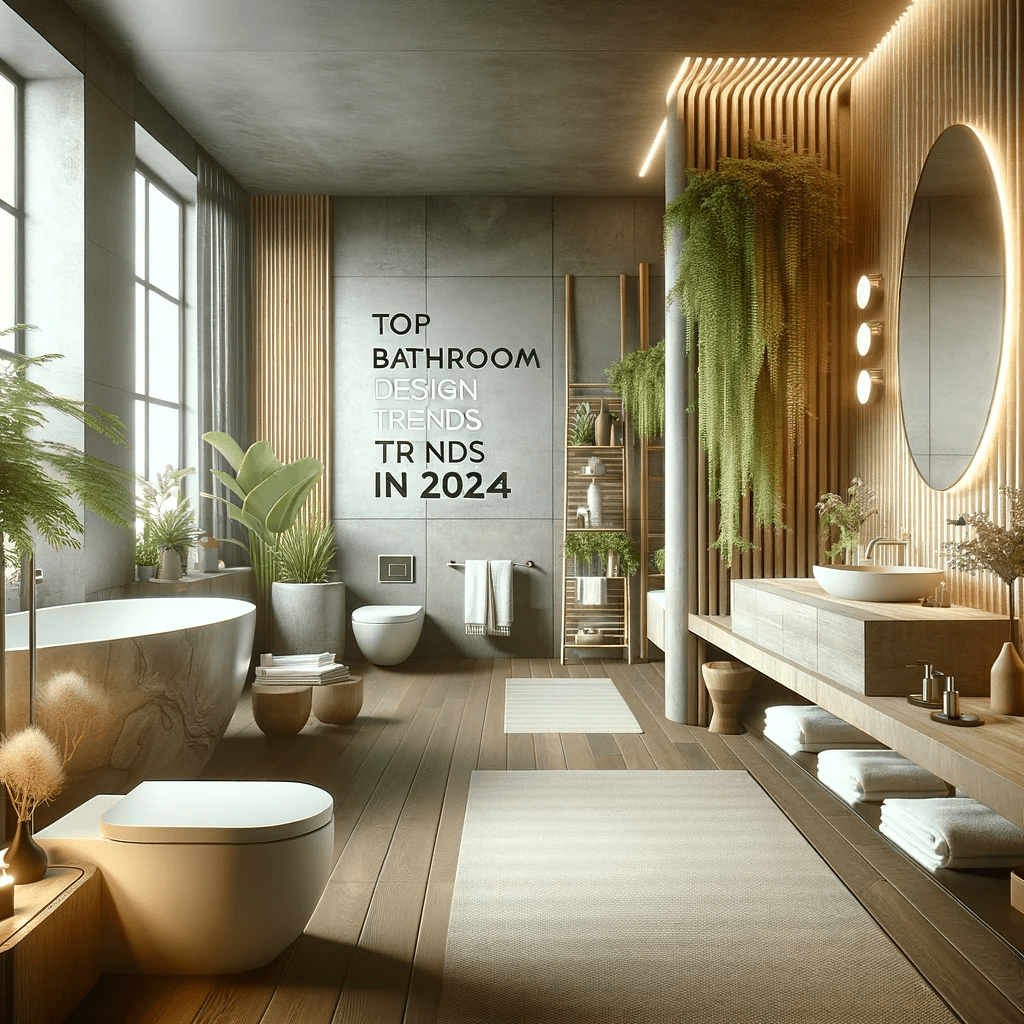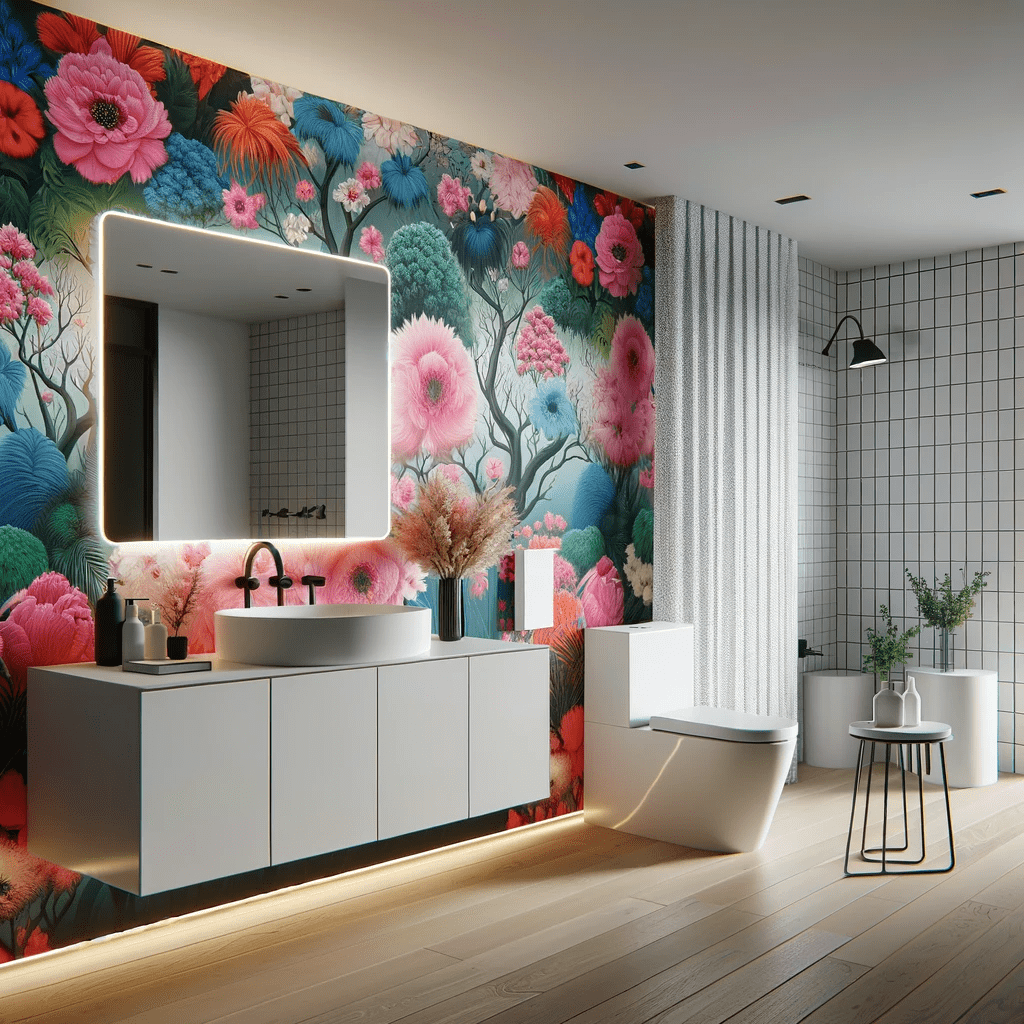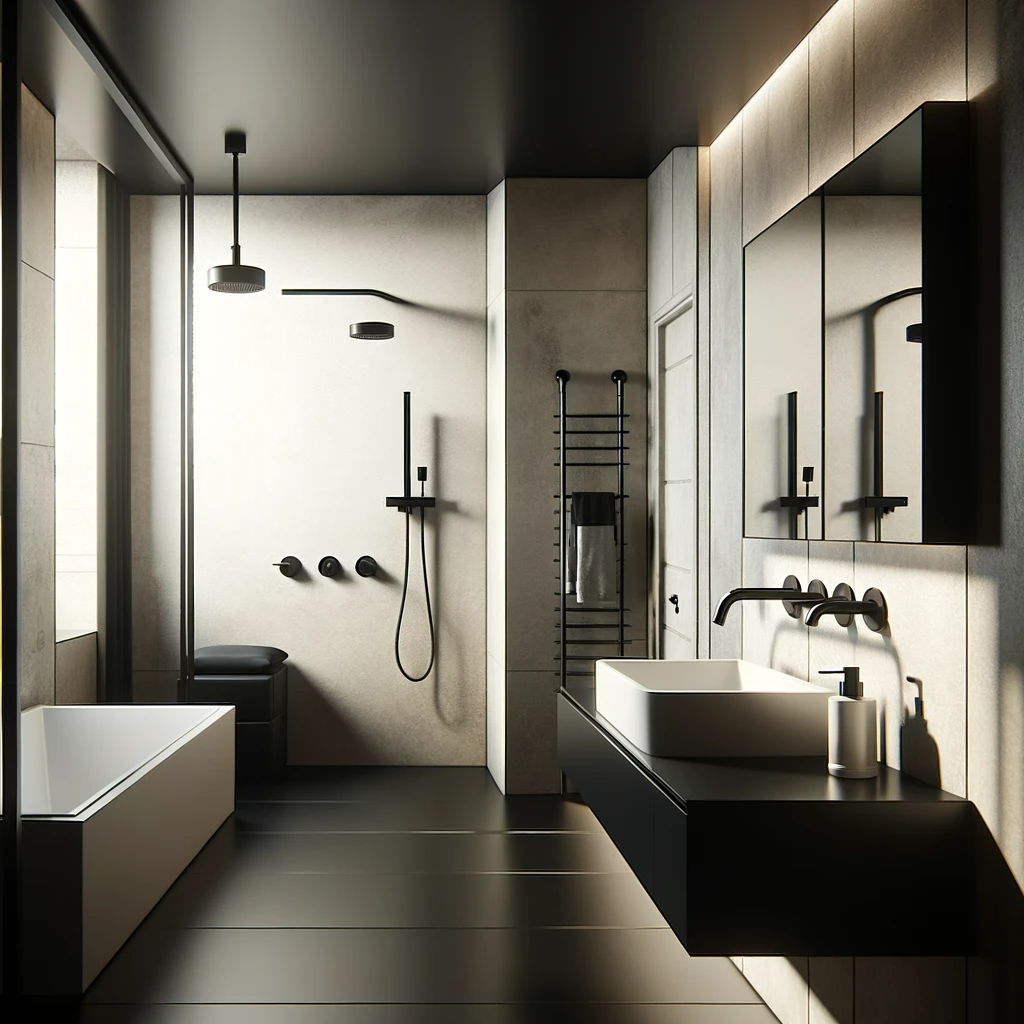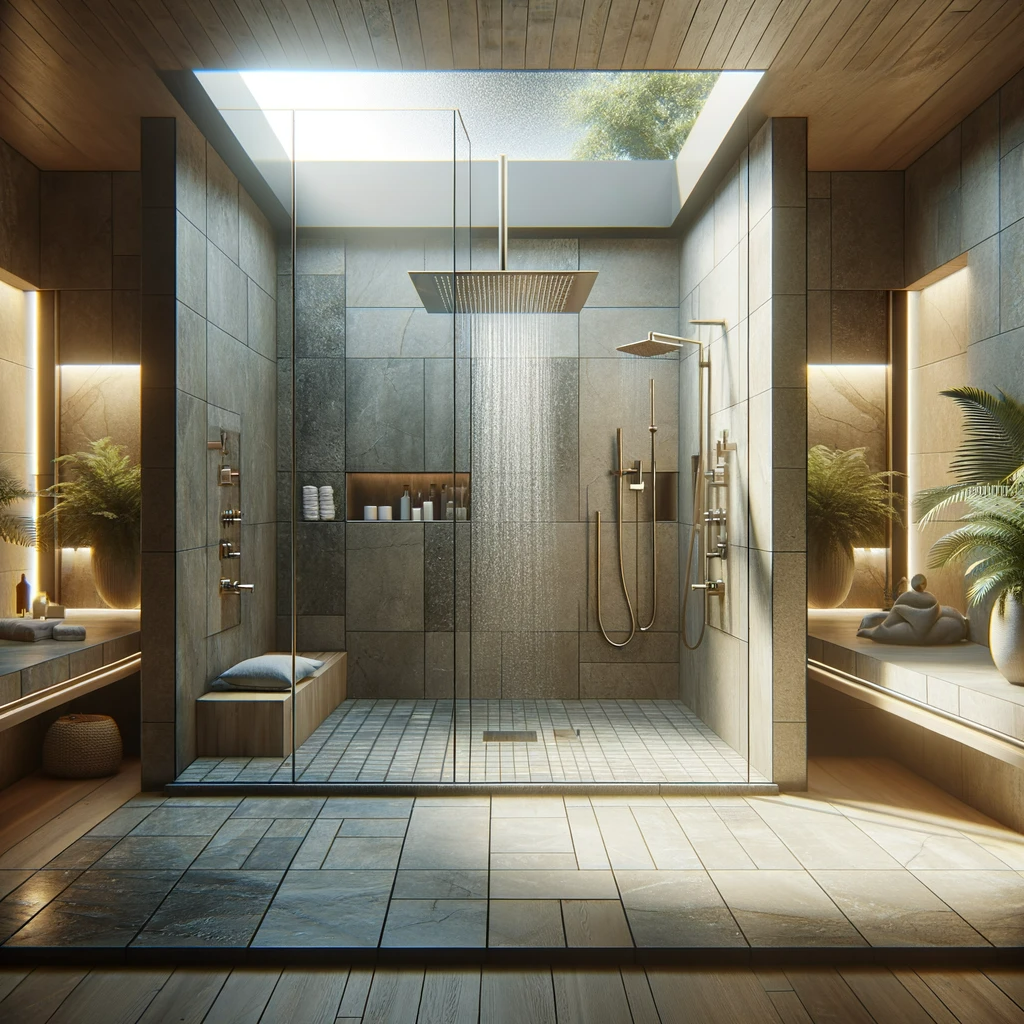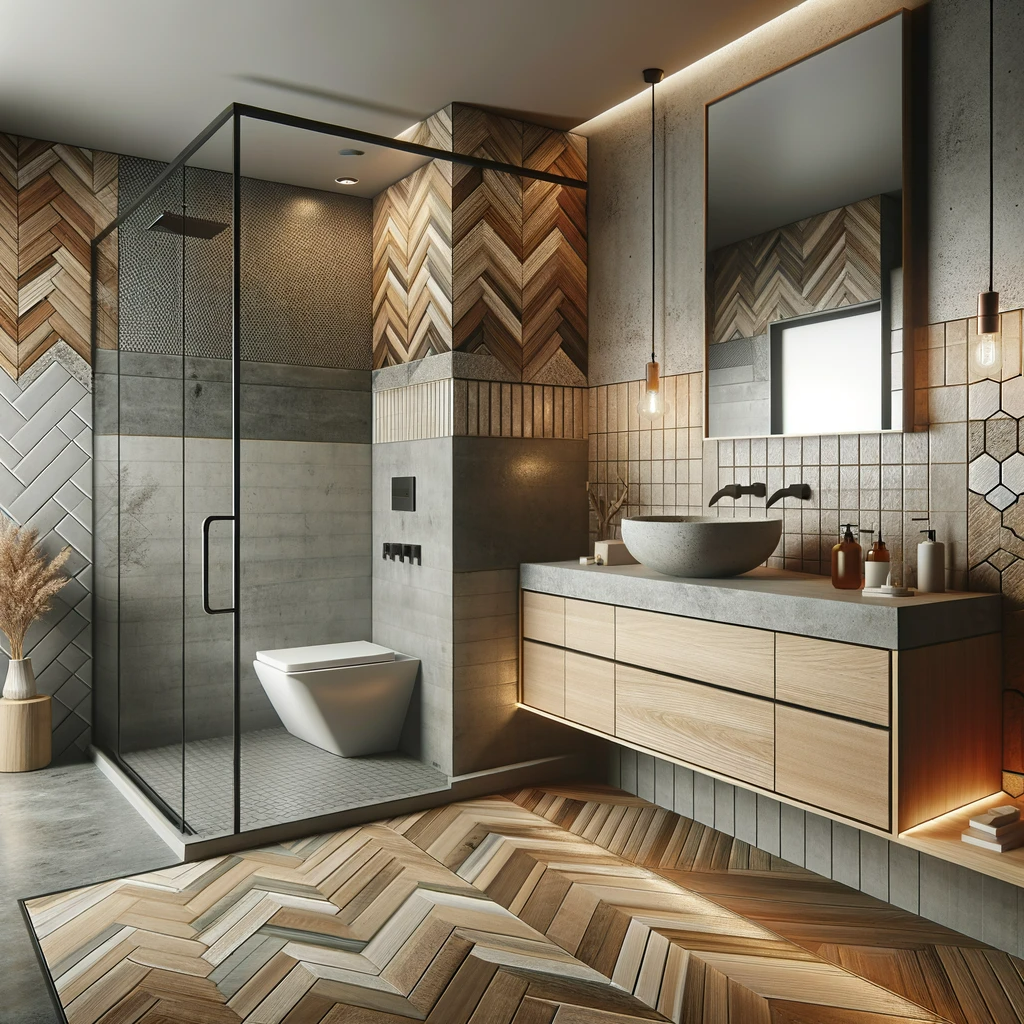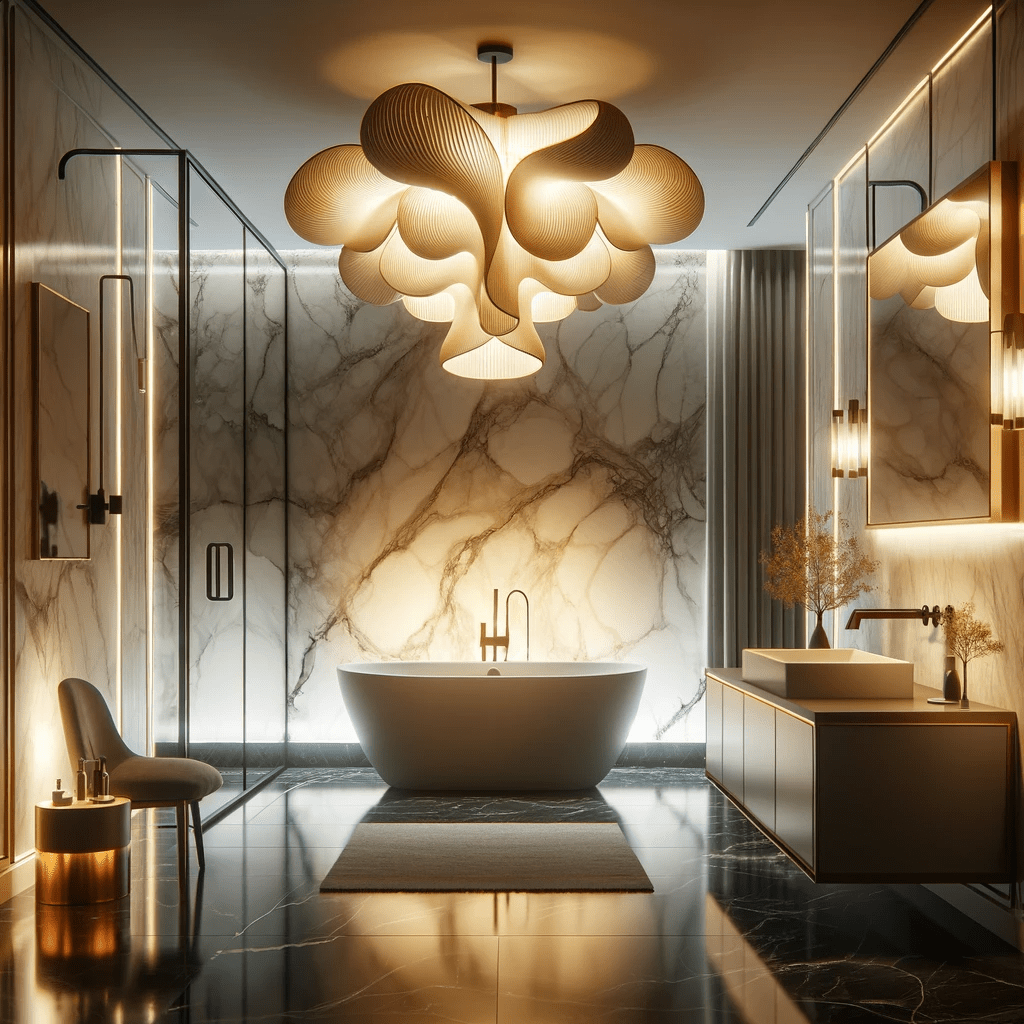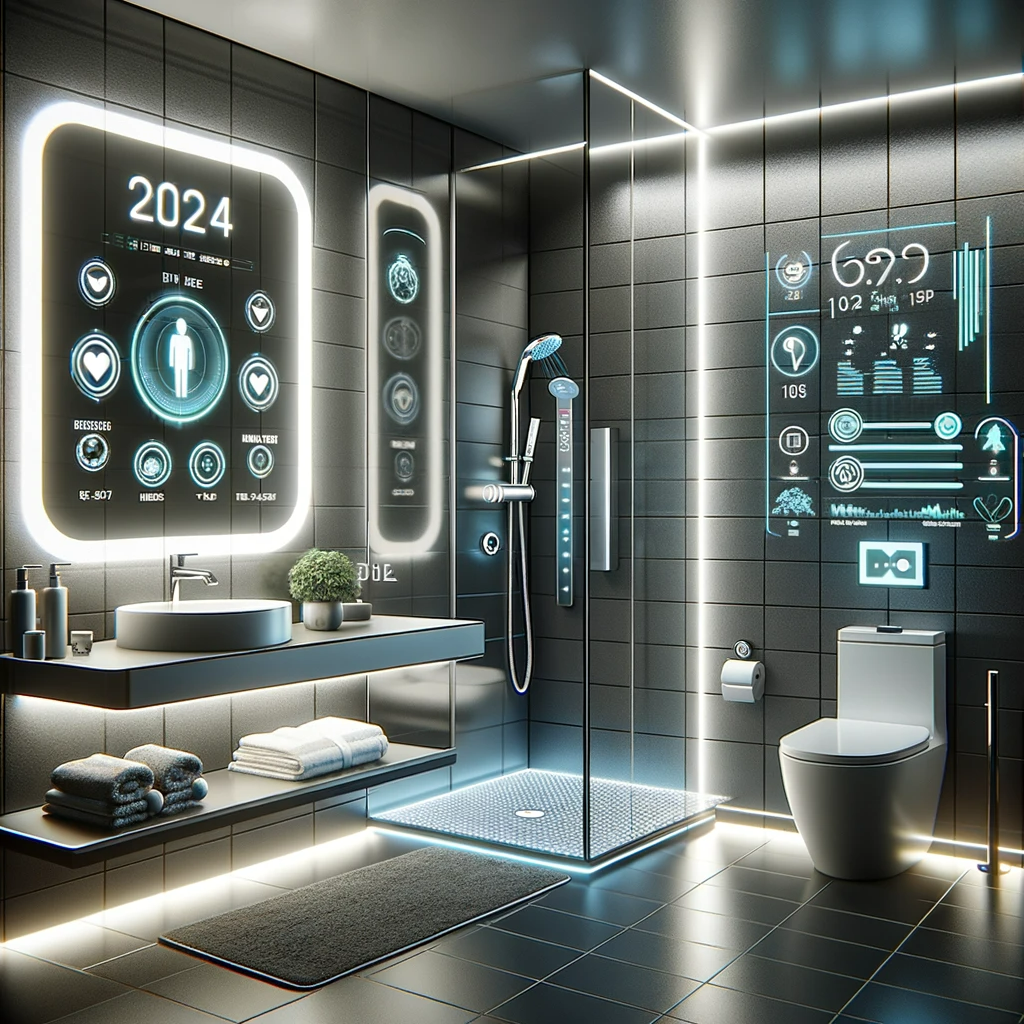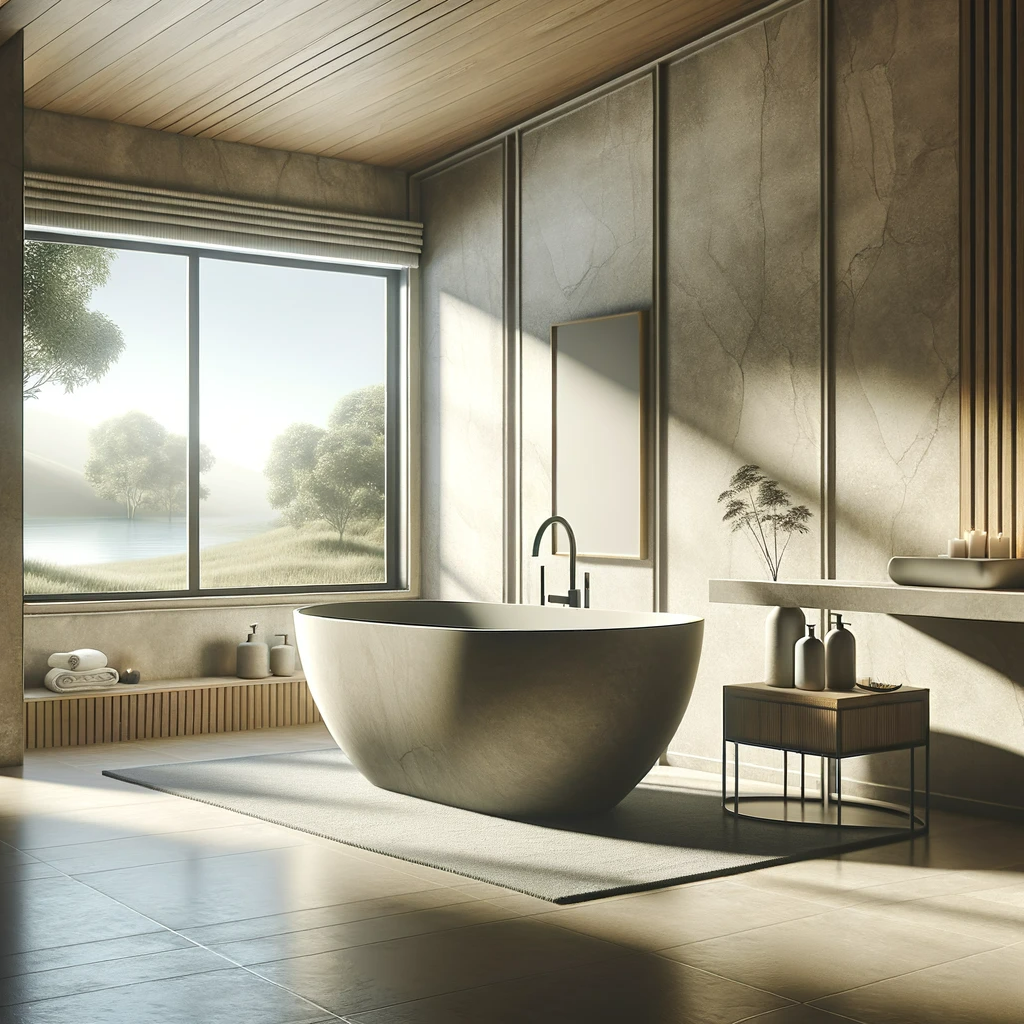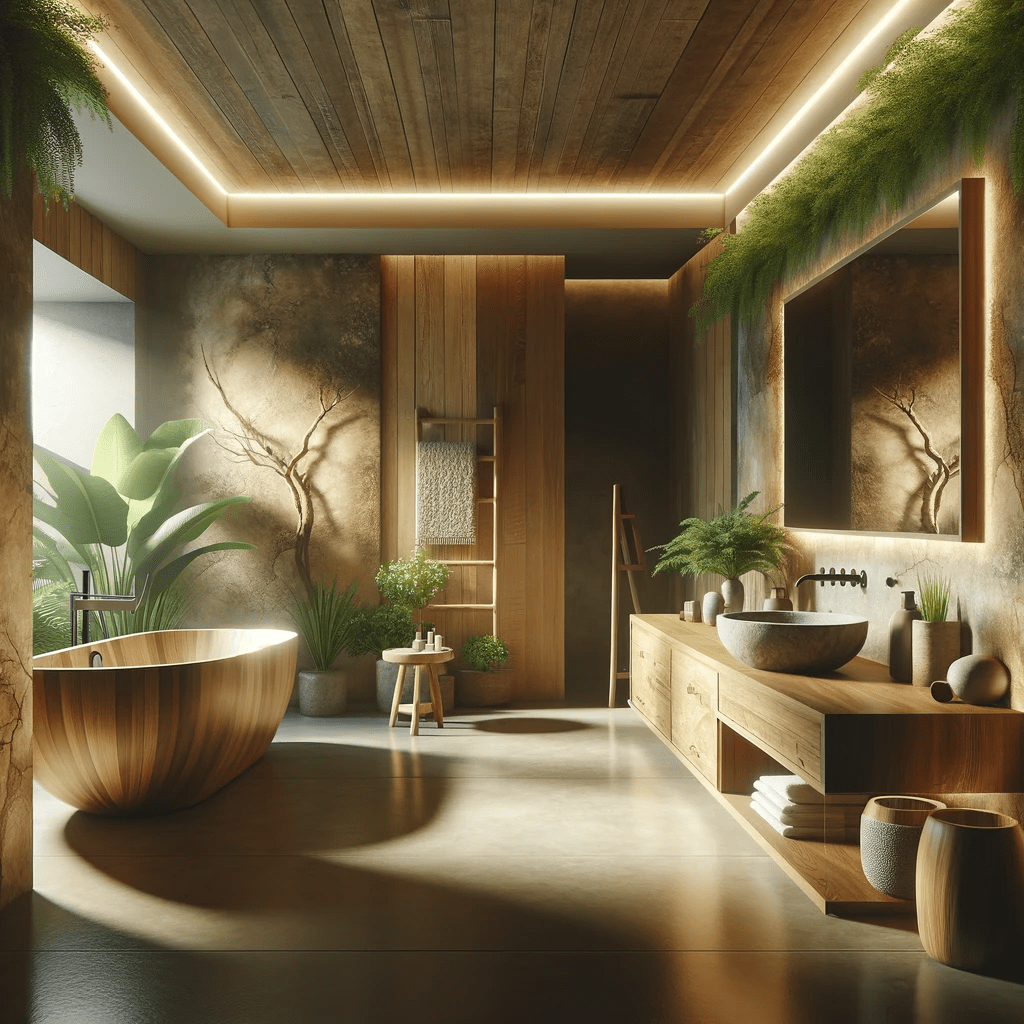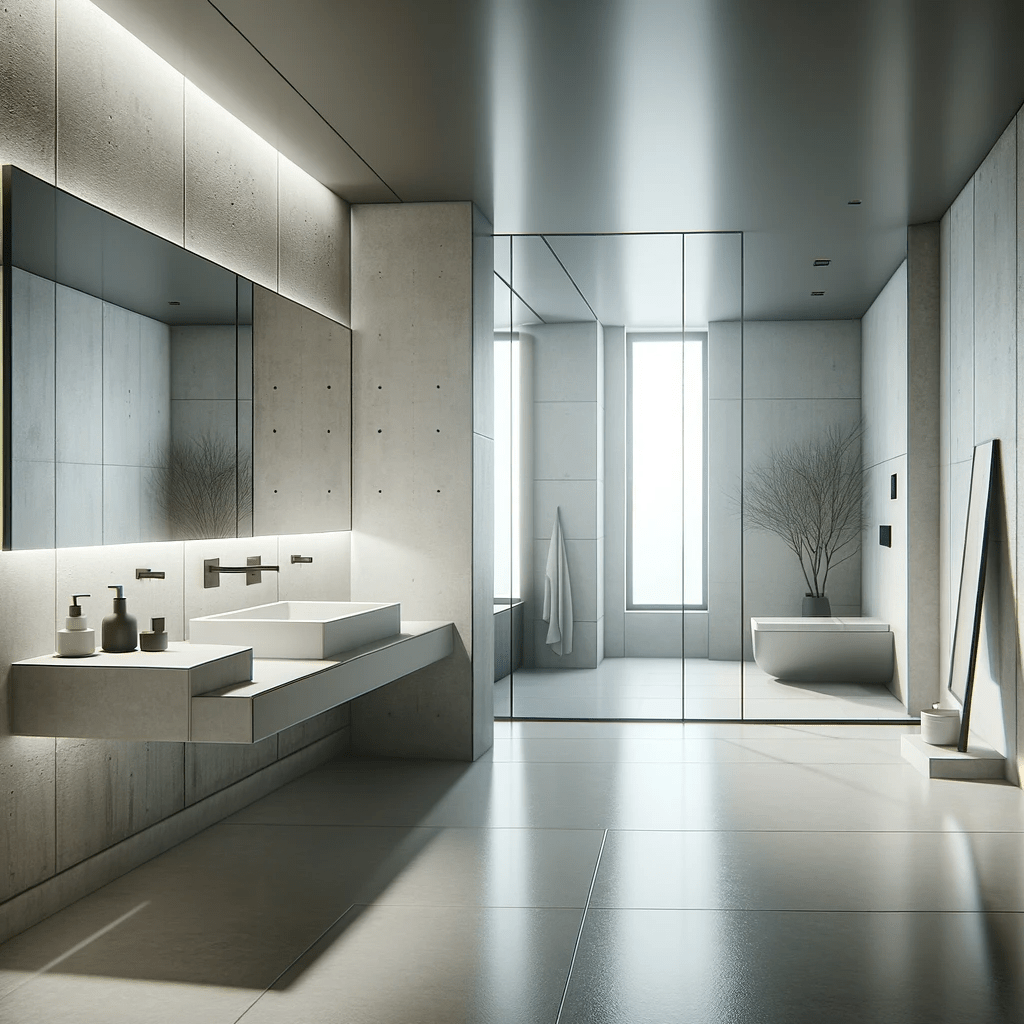Remodeling your bathroom is an exciting opportunity to update the look and functionality of one of the most important rooms in your home. Whether you’re looking for a complete overhaul or just a few updates, incorporating the latest design trends can help you create a stylish and modern space that meets your needs. Here are some of the top bathroom design trends to consider for your remodel.
Bold Wallpaper
Wallpaper is experiencing a renaissance in modern interior design, especially in bathrooms where it adds a splash of character and visual interest. The right wallpaper can transform a bathroom from plain to striking with just one feature wall or a complete room makeover.
Rising Trend and Preferences:
Design Surveys: Recent design surveys and forecasts show a growing preference for bold, large-scale patterns and colors in bathrooms.
Popular Patterns: Floral, geometric, and abstract designs are among the top choices, with a particular interest in vibrant colors and textures.
Types of Bold Wallpaper:
Vinyl Wallpaper: Due to its durability and resistance to humidity, vinyl wallpaper is a top choice for bathroom applications.
Peel-and-Stick Wallpaper: Ideal for DIY enthusiasts and renters looking for a temporary, easy-to-change solution.
Designer Collections: Many renowned designers are venturing into wallpaper, creating unique and high-quality options for a luxurious feel.
Benefits of Bold Wallpaper:
Visual Impact: A single statement wall can become the focal point of the bathroom, drawing the eye and adding depth.
Versatility: Wallpaper comes in countless designs, offering something for every taste and theme, from vintage to modern minimalism.
Personalization: It reflects personal style and can tie together various elements of the bathroom’s design.
Considerations for Choosing Wallpaper:
Moisture Resistance: Ensure the wallpaper is suitable for high-humidity areas to prevent peeling and mold.
Scale and Size: Consider the scale of the pattern in relation to the size of your bathroom; smaller spaces might benefit from a less busy pattern.
Color Scheme: Match or complement the colors in the wallpaper with fixtures and textiles in your bathroom.
Installation Tips:
Professional vs. DIY: While DIY is possible, especially with peel-and-stick options, professional installation ensures longevity and precision, especially for intricate patterns.
Preparation: Proper wall preparation is crucial, including cleaning, smoothing, and priming surfaces for the best results.
Incorporation Strategies:
Full Room vs. Accent Wall: Decide whether to cover all walls for a bold look or just one for a subtle yet impactful design statement.
Complementary Elements: Coordinate with bathroom accessories, towels, and art to create a cohesive look.
Maintenance and Longevity:
Cleaning: Use a damp cloth for cleaning; avoid harsh chemicals that might damage the wallpaper.
Longevity: High-quality vinyl and properly installed wallpaper can last many years, even in the bathroom’s challenging environment.
Table: Types of Bold Wallpaper for Bathroom Design
| Wallpaper Type | Visual Impact | Suggested Use | Installation Tips |
|---|---|---|---|
| Floral Patterns | Adds vibrant, natural beauty. Can range from subtle to dramatic. | Feature walls or full room for a statement look. | Ensure pattern alignment; consider scale relative to room size. |
| Geometric Shapes | Creates a modern, dynamic atmosphere. Often adds depth and movement. | Accent walls or alcove highlighting. | Precision in matching patterns is key; suitable for small or large spaces. |
| Abstract Designs | Offers artistic flair and uniqueness. Each pattern can tell a different story. | Focal wall or as a bold backdrop for fixtures. | Choose designs that complement bathroom fixtures and color scheme. |
| Metallic Finishes | Brings a touch of luxury and sophistication with reflective properties. | Small areas or as an accent to add glamour. | Consider lighting in the room as it can affect the wallpaper’s appearance. |
| Textured Wallpaper | Adds depth and a tactile element. Can mimic materials like fabric, wood, or stone. | Feature walls, behind the bathtub, or vanity areas. | Ensure bathroom ventilation is adequate to prevent moisture damage to textured papers. |
| Murals and Large Prints | Creates an immersive environment with large-scale imagery. | Wide uninterrupted walls for full effect. | Plan the layout carefully to accommodate fixtures and fittings without disrupting the image. |
Note: When selecting bold wallpaper for your bathroom, consider the room’s size, existing color scheme, and the overall style you wish to achieve. Ensure that the wallpaper is suitable for high-humidity environments, and consider professional installation for best results, especially for intricate patterns or textures.
Incorporating bold wallpaper into your bathroom remodel brings a dynamic and personalized element into the design. It’s a trend that embraces creativity and individuality, allowing for a dramatic or subtly sophisticated transformation. With the right choice and installation, bold wallpaper can become a lasting statement in your bathroom’s design narrative for 2024 and beyond.
Learn More About 5 Tips for an Age-Friendly Bathroom Remodel
Black Fixtures
In the world of bathroom design, black fixtures have surged in popularity, known for adding an element of sophistication and contemporary flair to the space. This trend encompasses everything from faucets and showerheads to cabinet handles and light fixtures, offering a bold contrast or a seamless match with a variety of design styles.
Trend Insights:
Market Growth: Design forecasts and market trends indicate an increased interest in black fixtures as a statement choice in bathrooms.
Style Versatility: Black fixtures complement a wide array of styles, from ultra-modern to rustic, fitting seamlessly with different color schemes and materials.
Types of Black Fixtures:
Faucets and Taps: Sleek and bold, black faucets are available in matte, glossy, or textured finishes.
Showerheads and Accessories: Black showerheads and accessories provide a striking focal point in showers and baths.
Hardware: Cabinet handles, towel bars, and light fixtures in black can tie the room together, creating a cohesive look.
Benefits of Black Fixtures:
Visual Impact: They stand out against both light and dark backgrounds, offering a striking visual appeal.
Timelessness: Black is a classic color that remains stylish over time, ensuring your bathroom design stays relevant.
Stain Resistance: Black fixtures often show fewer water spots and fingerprints, maintaining a clean look with less maintenance.
Design Considerations:
Balance and Contrast: Pair black fixtures with light-colored walls or tiles for a balanced look, or with dark tones for a bold, monochromatic theme.
Material Selection: Consider the material of the fixtures, such as stainless steel, brass, or plastic, which affects durability and finish.
Finish Consistency: Ensure all black fixtures have the same finish (matte, glossy, etc.) for a unified appearance.
Incorporation Strategies:
Accent or Theme: Decide whether black fixtures will serve as accent pieces or as part of a broader black-themed bathroom.
Mix and Match: Combine black fixtures with elements in other finishes, like chrome or gold, for a layered, eclectic look.
Installation and Care:
Professional Installation: Ensure fixtures are installed correctly to prevent leaks and maintain their appearance.
Regular Cleaning: Use appropriate cleaning agents for black finishes to prevent dulling or scratching.
Cost Implications:
Premium Pricing: While black fixtures can be more expensive than standard chrome or stainless steel, various options exist to fit different budgets.
Value Addition: Black fixtures can add perceived value to your bathroom, making them a worthwhile investment in the overall design.
Table: Types of Black Fixtures for Bathroom Design
| Fixture Type | Aesthetic Impact | Suggested Use | Design Tips |
|---|---|---|---|
| Faucets | Adds a sleek, modern touch or dramatic contrast. | Sinks, baths, and showers. | Coordinate with other fixtures; consider finish (matte, glossy, etc.). |
| Showerheads | Provides a focal point in the shower area. | Walk-in showers or over bathtubs. | Match with other shower fixtures and hardware for a cohesive look. |
| Towel Bars | Enhances the bathroom’s overall style. | Near the sink, shower, or bathtub. | Align style with other black fixtures; consider placement for visual balance. |
| Cabinet Handles | Subtle yet impactful way to incorporate black. | Vanity and storage cabinets. | Ensure ergonomic design and easy use; match with the cabinet’s style. |
| Light Fixtures | Influences the mood and ambiance of the bathroom. | Above the mirror, ceiling, or accent areas. | Choose a style that complements the bathroom’s theme; consider the light’s color temperature. |
| Accessories | Adds decorative touches and functional style. | Soap dispensers, toothbrush holders, etc. | Coordinate with the color scheme and other fixtures for a unified look. |
Note: Black fixtures can serve as a statement in themselves or work together to create a bold, cohesive theme in your bathroom. When incorporating black fixtures, consider the overall color palette and lighting in your bathroom, as these elements can significantly influence the fixtures’ visual impact and the room’s ambiance.
Black fixtures offer a dynamic and elegant addition to bathroom designs, suitable for various styles and preferences. They bring a modern edge and a sense of depth to the space, with the potential to transform the ambiance of your bathroom. By considering the balance, material, and overall design impact, you can effectively incorporate black fixtures into your remodel for a trendy, sophisticated look that stands the test of time.
Discover More About The Pros and Cons of Trendy vs. Timeless Bathroom Designs
Spa-Like Showers
As homeowners seek more luxurious and rejuvenating bathroom experiences, spa-like showers have become a defining trend in bathroom design. These showers transform a routine into an indulgence, featuring elements that mimic the serene and invigorating environment of a spa.
Popularity and Features:
Growing Trend: The demand for spa-like showers is increasing as people look for ways to create a personal retreat in their homes.
Key Features: Elements like rain showerheads, body sprays, handheld wands, and steam capabilities are popular in creating a multifaceted sensory experience.
Types of Spa Shower Features:
Rain Showerheads: Mimic the soothing feeling of rainfall, providing a gentle, relaxing shower experience.
Body Sprays and Jets: Offer a massage-like experience, targeting different areas of the body with adjustable water streams.
Steam Showers: Enclosed units that provide a steamy, sauna-like environment, helping with relaxation and deep skin cleansing.
Handheld Wands: Allow for targeted cleaning and flexibility, making them a practical addition to any spa-like shower.
Benefits of Spa-Like Showers:
Relaxation and Comfort: Create a tranquil space where you can unwind and relieve stress.
Health Benefits: Features like steam showers can improve circulation and respiratory health.
Enhanced Aesthetics: Spa-like showers are not only functional but also contribute significantly to the overall design and feel of the bathroom.
Design Considerations:
Space Requirements: Ensure your bathroom layout can accommodate the desired spa features, considering factors like plumbing and drainage.
Water Usage: Be mindful of water efficiency, opting for fixtures that provide a luxurious experience while still conserving water.
Material Selection: Use materials that can withstand constant moisture and heat, such as non-porous tiles and stainless steel.
Installation and Budget:
Professional Installation: Complex features like steam showers and multiple body jets often require professional installation to ensure proper functionality and safety.
Cost Implications: The cost can vary widely based on the features selected and the need for any structural changes to accommodate the new shower. Budgeting for high-quality materials and professional installation is key to longevity and performance.
Maintenance and Upkeep:
Regular Cleaning: Spa-like features, especially steam showers, require regular cleaning to prevent mold and mineral buildup.
Technical Maintenance: Periodic checks and maintenance of plumbing fixtures will ensure they continue to function effectively and safely.
Table: Features of Spa-Like Showers for Bathroom Design
| Feature | Benefit | Suggested Use | Implementation Tips |
|---|---|---|---|
| Rain Showerheads | Mimics natural rainfall for a relaxing experience. | Central ceiling position in the shower area. | Ensure adequate water pressure; consider adjustable models for height and angle. |
| Body Sprays and Jets | Provides a massage effect, targeting different areas of the body. | Integrated into shower walls at multiple levels. | Customize placement based on user height and preference; balance water usage. |
| Steam Generators | Creates a steam room experience for relaxation and detoxification. | Enclosed shower space with proper ventilation. | Professional installation required; ensure the bathroom has moisture-resistant materials. |
| Handheld Showerheads | Adds flexibility for targeted cleaning and accessibility. | Near main shower controls or as an additional feature. | Opt for an easily adjustable and detachable model with variable spray settings. |
| Thermostatic Mixers | Maintains consistent water temperature for comfort and safety. | Integral part of the shower system controls. | Professional installation advised; pair with anti-scald features for safety. |
| LED Shower Lights | Enhances mood and ambiance with color therapy options. | Embedded in the showerhead or ceiling. | Choose waterproof LED options; consider lights with adjustable colors and brightness. |
Note: When designing a spa-like shower, consider the overall bathroom layout, your personal wellness goals, and the practical aspects of installation and maintenance. Work with a professional to ensure that the plumbing, electrical, and structural elements are safely and properly implemented for a truly luxurious shower experience.
Incorporating spa-like features into your shower can transform your daily routine into a luxurious and therapeutic experience. While it requires careful planning, consideration of space, and investment, the benefits of having a personal spa retreat in the comfort of your home are unparalleled. By selecting the right features and ensuring quality installation, you can create a spa-like shower that offers relaxation, health benefits, and enhances the overall value and enjoyment of your bathroom.
Read More on Designing a Spa-Like Bathroom Retreat on a Budget
Mixed Materials
The trend of mixing materials is at the forefront of bathroom design, offering an innovative way to blend texture, color, and finish for a richly layered look. Combining wood, metal, stone, and other materials not only adds visual interest but also creates a unique and eclectic ambiance.
Why Mix Materials?
Aesthetic Appeal: Mixed materials break the monotony, adding depth and contrast to the bathroom.
Customization: Allows for a high degree of personalization, reflecting individual style and taste.
Versatility: Suitable for various design themes, from rustic charm to modern sophistication.
Popular Material Combinations:
Wood and Stone: Warm wood tones with cool stone create a balance of natural elements.
Metal and Glass: Sleek metals with clear or frosted glass offer a contemporary, clean look.
Ceramic and Natural Fibers: Combining ceramic tiles with natural fiber rugs or baskets adds warmth and texture.
Considerations for Material Selection:
Durability: Ensure materials are suitable for the moist and varied conditions of a bathroom.
Maintenance: Consider the care required for each material, aiming for a balance between beauty and practicality.
Harmony: While contrast is desirable, ensure the materials complement each other and the overall design theme.
Incorporation Strategies:
Fixtures and Fittings: Mix metals for faucets, showerheads, and handles; consider different finishes like matte, brushed, or polished.
Flooring and Walls: Combine different tile patterns, sizes, and materials for flooring and walls to create distinct zones or features.
Accessories and Decor: Introduce varied materials through mirrors, storage containers, light fixtures, and other bathroom accessories.
Design Tips:
Color Coordination: Maintain a cohesive color palette to unify the different materials.
Texture Play: Mix smooth and rough textures to enhance tactile and visual interest.
Proportion and Scale: Balance large and small elements, ensuring the space doesn’t feel overwhelmed by any one material.
Budgeting:
Cost-Effective Mixes: Pairing luxury materials with more economical options can achieve a high-end look without breaking the bank.
Splurge vs. Save: Decide where to splurge on premium materials and where to save with cost-effective alternatives.
Table: Mixed Material Combinations for Bathroom Design
| Material Combination | Aesthetic Appeal | Suggested Applications |
|---|---|---|
| Wood and Stone | Warm and natural, offering a balance of earthy tones and textures. | Vanity tops with stone counters, wooden cabinets, stone-tiled walls or floors. |
| Metal and Glass | Sleek and modern, providing a clean and minimalist look. | Metal fixtures with glass shower doors, glass shelving with metal brackets. |
| Ceramic and Natural Fibers | Cozy and inviting, adding tactile warmth. | Ceramic tiles with natural fiber rugs, wicker baskets, or bamboo shades. |
| Stone and Metal | Sophisticated and durable, combining sturdy elegance with industrial chic. | Stone basins with metal faucets, metal towel racks on stone walls. |
| Wood and Metal | Rustic meets industrial, creating a contrast of warm wood with cool metal. | Wooden shelving with metal frames, metal light fixtures with wooden accents. |
Note: The suggested applications are intended to inspire and guide your material mix choices in bathroom design. Consider the overall theme and balance of your bathroom when mixing materials.
Mixing materials in your bathroom remodel introduces diversity and character into the space, making it distinctly yours. By strategically selecting and combining various materials, you can create a bathroom that’s not only visually appealing but also a reflection of your personal style. With careful planning, a mix of materials can transform your bathroom into a sophisticated and inviting space that stands out in 2024 and beyond.
Find Out About The Benefits of an Open-Concept Bathroom Design
Statement Lighting
Statement lighting is not just functional; it’s a central piece of art in bathroom design. Chandeliers, pendant lights, and wall sconces are among the popular choices that can transform the ambiance of a bathroom, adding layers of light and style. These fixtures can serve as a dramatic focal point or provide a subtle yet luxurious touch.
Trend and Popularity:
Growing Demand: Design trends are increasingly recognizing lighting as a critical element in bathroom aesthetics.
Variety of Styles: From modern minimalist designs to ornate vintage pieces, statement lighting fixtures are available in an array of styles to suit any taste.
Types of Statement Lighting:
Chandeliers: Offer a classic or modern glam look, perfect for larger bathrooms or over bathtubs.
Pendant Lights: Provide focused lighting with style, suitable for vanity areas or as central ceiling fixtures.
Wall Sconces: Enhance ambiance and add sophistication on either side of a mirror or along the walls.
Benefits of Statement Lighting:
Visual Impact: Immediately draws the eye, adding a layer of luxury and sophistication.
Mood Setting: The right lighting can transform the mood of the space, from bright and energetic to soft and relaxing.
Versatility: Works with various design themes and can be updated easily to refresh the bathroom’s look.
Design Considerations:
Scale and Proportion: Choose a size that complements the space without overwhelming it.
Lighting Layers: Combine statement fixtures with other light sources for a balanced and functional lighting scheme.
Safety and Suitability: Ensure fixtures are rated for bathroom use, considering moisture and safety standards.
Installation Tips:
Professional Installation: For safety and precision, professional installation is recommended, especially for fixtures that require electrical work.
Placement: Consider the placement carefully for both aesthetic impact and practical use, avoiding glare and shadows.
Cost and Budgeting:
Investment Piece: While statement lighting can be an investment, various options cater to different budgets.
Cost vs. Impact: The right lighting fixture can significantly alter the room’s feel, making it a cost-effective way to upgrade the decor.
Maintenance and Upkeep:
Cleaning: Regular cleaning is necessary to maintain the beauty and functionality of statement lighting fixtures.
Bulb Replacement: Choose fixtures that allow for easy bulb replacement to ensure continued enjoyment of the light.
Table: Types of Statement Lighting for Bathroom Design
| Lighting Type | Ideal Placement | Style Impact | Notes |
|---|---|---|---|
| Chandeliers | Above the bathtub or center of the room | Adds grandeur and luxury; best for larger bathrooms or high ceilings | Ensure moisture-rated for safety; consider size in proportion to the space |
| Pendant Lights | Above the vanity or freestanding tub | Modern and focused; provides task lighting with style | Adjustable height can accommodate various spaces; use in pairs or clusters for balance |
| Wall Sconces | Flanking the mirror or along the walls | Subtle yet elegant; enhances the ambiance and complements main lights | Coordinate with other fixtures for a cohesive look; consider dimmable options for mood lighting |
| LED Strip Lights | Under vanity, around mirrors, or in coves | Contemporary and sleek; adds a soft glow and highlights architectural features | Versatile and energy-efficient; can be used to outline areas or as accent lighting |
| Recessed Spotlights | In the ceiling or shower area | Clean and minimalist; provides bright, focused lighting | Great for low ceilings or in combination with other statement pieces; ensure waterproof rating for shower placement |
Note: When selecting statement lighting, consider the overall design theme, size of your bathroom, and existing electrical configurations. Always ensure that lighting choices are appropriate for the moisture levels and usage of a bathroom environment.
Statement lighting is a powerful tool in bathroom design, capable of transforming the space into a stylish and inviting area. By carefully selecting and installing the right fixture, you can create a focal point that enhances the overall aesthetic and mood of your bathroom. Whether you’re going for bold and dramatic or subtle and chic, the 2024 trends in statement lighting offer exciting possibilities to illuminate your bathroom remodel with style.
Small Bathroom, Big Impact: Creative Design Solutions for Limited Space
Smart Features
The integration of smart technology into bathroom design is not just a trend; it’s revolutionizing the way we interact with our most personal space. Heated floors, voice-activated lighting, Bluetooth speakers, and more are becoming commonplace, offering unprecedented levels of convenience and luxury. These innovations cater to a desire for comfort, efficiency, and a personalized bathroom experience.
Rising Trend in Smart Bathrooms:
Consumer Interest: Surveys indicate a growing interest in smart home features, with bathrooms being a prime focus for tech integration.
Innovative Solutions: Advances in technology are continuously expanding the possibilities for smart features in bathroom design.
Popular Smart Bathroom Features:
Heated Floors: Step into comfort with temperature-controlled flooring that eliminates the chill of tiles, especially appreciated in colder climates.
Voice-Activated Lighting: Adjust lighting levels and colors through voice commands to create the perfect ambiance for any time of the day.
Bluetooth Speakers: Integrated speakers allow for a personalized audio experience, from news and podcasts to relaxing music.
Smart Mirrors: Interactive mirrors can display time, weather, news, or even integrate with other smart home systems.
Digital Showers: Customize water temperature, flow, and even shower duration with digital controls for a perfect shower every time.
Benefits of Incorporating Smart Features:
Enhanced Convenience: Control various aspects of your bathroom environment with just a voice command or the touch of a button.
Energy Efficiency: Many smart features offer energy-saving benefits, reducing costs and environmental impact over time.
Personalization: Tailor your bathroom experience to your preferences, from lighting moods to music selection.
Considerations for Smart Features:
Compatibility: Ensure that chosen features are compatible with your home’s existing systems and devices.
Water Resistance: Given the bathroom’s moist environment, opt for water-resistant or waterproof technology.
Future-Proofing: Choose upgradable solutions that can adapt to emerging technologies and trends.
Installation and Budgeting:
Professional Installation: Some smart features require professional installation, especially for integrated systems like heated floors or digital showers.
Cost Implications: While initial costs may be higher, consider the long-term value of convenience, energy savings, and enhanced experience.
Maintenance and Upkeep:
Regular Updates: Keep software and devices updated for optimal performance and security.
Technical Support: Ensure access to reliable technical support for troubleshooting and repairs.
Table: Smart Bathroom Features Comparison
| Smart Feature | Benefit | Typical Application | Notes |
|---|---|---|---|
| Heated Floors | Warmth and comfort; energy-efficient | Under tile or stone flooring | Consider zone control for efficiency |
| Voice-Activated Lighting | Convenience; personalized ambiance | Overhead, vanity, or accent lighting | Compatible with smart home assistants |
| Bluetooth Speakers | Entertainment and information | Integrated into walls or mirrors | Water-resistant models are advisable |
| Smart Mirrors | Information display; interactivity | Above vanity | May include features like LED lighting, touch control |
| Digital Showers | Precision control; water efficiency | Shower area | Customize temperature, flow, and duration |
| Automatic Faucets | Hygiene; water conservation | Sink area | Touchless operation reduces water waste |
| Smart Toilets | Hygiene and comfort; water efficiency | Toilet | Features may include bidet functions, seat warming, self-cleaning |
Note: When incorporating smart features, consider your household’s specific needs and the compatibility of different technologies. It’s also essential to factor in installation requirements and long-term maintenance to ensure that these features continue to offer convenience and efficiency.
Smart features represent the cutting edge of bathroom design, offering a blend of luxury, comfort, and technological innovation. By carefully selecting smart features that enhance your daily routine and meet your needs, you can create a bathroom that is not only functional but also a testament to modern living. As you plan your remodel for 2024, consider how these intelligent solutions can transform your bathroom into a space that feels truly yours.
Dive Into Tips for Maximizing Natural Light in Your Bathroom Remodel
Freestanding Tubs
Freestanding tubs have become synonymous with luxury and relaxation in modern bathroom design. These tubs serve as a stylish centerpiece, offering an inviting appeal with their elegant lines and sculptural quality. Available in various designs, from classic clawfoot to sleek contemporary styles, they provide a spa-like look and feel, making every bath a luxurious escape.
Popularity and Style Evolution:
Design Trend: Increasingly sought after for their aesthetic appeal and comfort, freestanding tubs are a focal point in bathroom renovations.
Style Range: Options include traditional shapes, organic forms, and minimalist designs, catering to diverse tastes and bathroom themes.
Types of Freestanding Tubs:
Clawfoot Tubs: Classic and vintage, offering a timeless appeal.
Soaking Tubs: Deeper than standard tubs, designed for a full-body soak.
Modern Tubs: Characterized by clean lines and often made from materials like acrylic or stone resin.
Benefits of Freestanding Tubs:
Visual Impact: Creates a striking visual centerpiece in the bathroom.
Flexibility in Placement: Unlike built-in tubs, they can be placed anywhere in the bathroom where plumbing allows.
Variety of Materials: Available in acrylic, cast iron, stone, and more, each offering its own aesthetic and thermal properties.
Considerations for Choosing a Freestanding Tub:
Size and Scale: Ensure the tub fits comfortably in your bathroom space and allows for easy movement around it.
Weight: Consider the weight of the tub, especially for stone or cast iron options, and ensure your floor can support it.
Plumbing Requirements: Placement might affect plumbing configuration; freestanding faucets or wall-mounted taps may be needed.
Installation and Budgeting:
Installation Costs: Can vary significantly based on the tub’s material and plumbing requirements.
Price Range: While there are options for various budgets, luxury materials and designs can be a significant investment.
Maintenance and Upkeep:
Cleaning: Easier access around the tub makes for simpler cleaning, but some materials may require special care.
Durability: Choose a tub with a durable finish to maintain its appearance over time.
Types of Freestanding Tubs and Their Characteristics
| Tub Type | Characteristics | Aesthetic Impact | Installation Considerations |
|---|---|---|---|
| Clawfoot | Traditional design with distinctive feet. Available in classic and modern styles. | Adds a vintage or nostalgic charm to the bathroom. | Requires adequate floor support and may need freestanding or wall-mounted plumbing fixtures. |
| Soaking | Deeper and wider design for full-body immersion. Often has a simple, modern look. | Offers a spa-like, luxurious feel. Suited for relaxation and comfort. | Consider the tub’s weight when full and ensure easy access for entry and exit. |
| Modern | Sleek lines, minimalistic shapes. Made from materials like acrylic or stone resin. | Provides a contemporary and clean look. Fits well in minimalist or modern bathrooms. | Lightweight options like acrylic are available, but placement should be planned for plumbing access. |
| Oval/Round | Curved, flowing lines without sharp edges. Available in various sizes. | Softens the bathroom’s look with organic shapes. Creates a focal point. | Requires space around the tub for visual balance and ease of cleaning. |
| Cast Iron | Heavy and durable, with a classic look. Often has an enamel coating. | Brings an elegant, timeless aesthetic. Retains heat well for long soaks. | Floor reinforcement might be necessary due to weight. Regular maintenance to prevent chipping or rust. |
Note: When selecting a freestanding tub, consider the overall design theme of your bathroom, the available space, and how the tub’s style and material will complement other fixtures and finishes. Additionally, consult with a professional to ensure proper installation and compatibility with your bathroom’s structural and plumbing systems.
Freestanding tubs are a statement of luxury and style in bathroom design, transforming the space into a personal sanctuary. They not only elevate the room’s aesthetics but also enhance the bathing experience, offering a place for relaxation and retreat. As you plan your 2024 bathroom remodel, consider how a freestanding tub might add comfort, elegance, and value to your home.
Uncover Details on How to Choose the Right Color Scheme for Your Bathroom Renovation
Natural Materials
Natural materials like wood, stone, and marble are making a significant impact in bathroom design, favored for their ability to bring a touch of nature’s tranquility and timeless elegance into the home. These materials offer a diverse range of textures, colors, and patterns, each adding its unique feel and atmosphere to the bathroom space. By incorporating natural elements, you can create a serene and organic ambiance that promotes relaxation and connection to the natural world.
Trend in Natural Aesthetics:
Growing Popularity: Homeowners and designers are increasingly drawn to the organic appeal and sustainable aspect of natural materials.
Versatility: Suitable for various design themes, from rustic to modern luxury, natural materials can be adapted to fit any taste.
Types of Natural Materials:
Wood: Brings warmth and a sense of comfort. Commonly used in vanities, shelving, and accents.
Stone: Offers durability and a unique texture. Popular for countertops, walls, and floors.
Marble: Known for its luxurious veining and polish, ideal for countertops, flooring, and wall cladding.
Benefits of Using Natural Materials:
Aesthetic Appeal: Each piece is unique, adding character and depth to your bathroom design.
Durability: When properly sealed and maintained, materials like stone and marble are long-lasting.
Sustainability: Many natural materials are eco-friendly, appealing to environmentally conscious homeowners.
Considerations for Incorporating Natural Materials:
Maintenance Requirements: Some natural materials require regular sealing or specific cleaning methods to maintain their appearance and durability.
Compatibility with Bathroom Conditions: Ensure the chosen materials are suitable for wet and humid conditions typically found in bathrooms.
Budget Implications: While natural materials can be an investment, they vary widely in price, offering options for different budgets.
Design Tips:
Mix and Match: Combine different natural materials for a layered, textured look. For example, stone tiles with a wooden vanity.
Highlight Features: Use striking materials like marble as a focal point on a feature wall or countertop.
Balance with Other Elements: Pair natural materials with modern fixtures and neutral colors for a balanced, contemporary feel.
Installation and Care:
Professional Installation: Ensuring correct installation is crucial, especially for heavy materials like stone or marble.
Regular Maintenance: Understand the care requirements of each material, including sealing, cleaning, and avoiding harsh chemicals.
Table: Natural Materials in Bathroom Design
| Material | Characteristics | Common Applications | Maintenance Notes |
|---|---|---|---|
| Wood | Warm and inviting with a variety of grains and finishes. | Vanities, shelving, bathtub surrounds, and accents. | Requires sealing for moisture resistance; regular cleaning with mild soap. |
| Stone | Durable and unique, available in many types like slate, granite, and limestone. | Countertops, flooring, shower walls, and sinks. | Sealant needed for porous stones; clean spills quickly to avoid stains. |
| Marble | Luxurious with distinctive veining; available in polished or honed finishes. | Countertops, flooring, walls, and bathtub decks. | Requires periodic sealing; use pH-neutral cleaners to prevent etching. |
| Travertine | Characterized by pitted holes and troughs in its surface. | Flooring, shower walls, and backsplashes. | Fill holes and regularly seal; wipe up spills to prevent staining. |
| Bamboo | Eco-friendly and resilient with a distinctive look. | Flooring, cabinetry, and matting. | Use specific bamboo cleaners; avoid prolonged water exposure. |
| Natural Stone Tiles | Versatile and practical, available in various types and cuts. | Flooring, shower surrounds, and feature walls. | Sealant application varies by stone type; regular cleaning required. |
Note: When incorporating natural materials into your bathroom, consider the overall design theme, the specific space where the material will be used, and its interaction with water and humidity. Consult with professionals regarding the best practices for installation and maintenance to ensure longevity and appearance.
Natural materials offer a unique blend of beauty, durability, and timelessness, making them a sought-after choice in bathroom design. They provide an opportunity to create a space that feels both luxurious and grounding, reflecting the beauty of the natural world. As you consider your remodel in 2024, incorporating natural materials can be a valuable investment in the comfort, style, and sustainability of your bathroom.
Explore Further about How to Make the Most of Your Bathroom Layout
Minimalist Design
Minimalist design remains a steadfast trend in bathroom design, appealing for its clean aesthetic, serene ambiance, and timeless appeal. This style is characterized by its simplicity, clean lines, uncluttered spaces, and a monochromatic color palette, focusing on functionality and essential beauty. By stripping down to the basics, minimalist bathrooms create a tranquil retreat from the busy world.
The Essence of Minimalism:
Simplicity and Functionality: Focuses on the essentials to create a space that is both functional and straightforward.
Visual Clarity: A clutter-free environment achieved through efficient storage and organization.
Key Features of Minimalist Design:
Clean Lines and Shapes: Straight, sleek lines in fixtures, cabinetry, and tiling.
Neutral Palette: Whites, beiges, grays, and blacks that create a calm and cohesive look.
Uncomplicated Fixtures: Simple, functional fixtures and hardware that don’t distract from the overall aesthetic.
Benefits of Minimalist Bathrooms:
Timeless Appeal: Less likely to feel outdated as trends change.
Easier to Clean: Fewer items and simpler surfaces make for easy cleaning and maintenance.
Space Maximization: The illusion of more space through a less-is-more approach.
Design Elements:
Materials: Use materials like glass, smooth stone, or polished metal to emphasize clean lines and surfaces.
Lighting: Recessed or streamlined lighting fixtures that blend with the room’s aesthetic.
Storage: Hidden or integrated storage solutions to maintain a clutter-free environment.
Incorporation Strategies:
Focus on Quality: Choose fewer but higher-quality pieces that align with the minimalist philosophy.
Visual Balance: Even in minimalism, add character through textural contrasts or a single statement piece without overwhelming the space.
Technology Integration: Consider smart features that enhance functionality while maintaining the minimalist look.
Color and Decor:
Monochromatic Scheme: Stick to a single color palette for a harmonious look.
Subtle Accents: Introduce subtle variations or accents in textures or materials rather than color.
Challenges and Considerations:
Functionality vs. Aesthetics: Ensure that the minimalist design does not compromise on the bathroom’s functionality.
Warmth and Comfort: Use textures and lighting to add warmth and comfort to avoid a too sterile look.
Table: Elements of Minimalist Bathroom Design
| Element | Design Impact | Implementation Tips |
|---|---|---|
| Clean Lines and Shapes | Creates a sleek, uncluttered look. | Choose fixtures and furniture with simple, geometric forms. |
| Neutral Palette | Establishes a serene, cohesive atmosphere. | Stick to whites, grays, and other muted tones for walls, tiles, and decor. |
| Uncomplicated Fixtures | Enhances the functionality without distracting from the overall aesthetic. | Opt for streamlined faucets, sinks, and bathtubs with minimal detailing. |
| Streamlined Lighting | Provides illumination without visual clutter. | Use recessed lighting, simple pendants, or LED strips that blend into the architecture. |
| Integrated Storage | Keeps the space tidy and open. | Incorporate built-in shelving, hidden cabinets, or under-counter storage to minimize visible clutter. |
| Quality over Quantity | Ensures each piece contributes to the design and function. | Select a few high-quality, well-designed items instead of numerous average pieces. |
| Textural Contrast | Adds depth and interest in a subtle way. | Introduce variety through materials like smooth stone, polished metal, or matte finishes. |
Note: When implementing minimalist design, the goal is to create a harmonious and functional space. Each element should contribute to the overall calm and order of the bathroom, reflecting the minimalist ethos of “less is more.” Careful planning and consideration of materials, colors, and layout are essential to achieving a successful minimalist bathroom design.
Minimalist design in bathroom remodeling offers a way to create a peaceful, clean, and modern space. It’s about choosing quality over quantity, embracing simplicity, and focusing on the essentials to create a room that is both functional and stylish. As you consider your remodel in 2024, incorporating minimalist design principles can help ensure that your bathroom is a tranquil, timeless haven.
Investigate 10 Steps for Creating a Cohesive Design Plan for Your Bathroom Renovation
Custom Storage Solutions
In the quest for both functionality and aesthetics, custom storage solutions are becoming a cornerstone of bathroom design. Tailored to fit individual needs and spaces, these solutions range from bespoke cabinets and vanities to unique shelving and built-ins. Custom storage allows homeowners to maximize every inch of their bathroom, providing a place for everything while contributing to the overall style of the space.
Importance of Custom Storage:
Efficient Use of Space: Designed to fit specific dimensions and layouts, making the most of available space.
Personalization: Tailored to individual storage needs, accommodating everything from towels and toiletries to makeup and medicine.
Types of Custom Storage Solutions:
Custom Cabinets and Vanities: Built to exact specifications for size, style, and functionality.
Built-in Shelving: Integrated into walls or shower spaces for a sleek look and space-saving storage.
Pull-out Storage: Hidden compartments and drawers that maximize space and accessibility.
Benefits of Custom Storage:
Enhanced Organization: Keeps everything neatly organized and easily accessible.
Aesthetic Integration: Seamlessly blends with the bathroom’s design, enhancing its appearance.
Increased Home Value: Well-designed storage solutions can be a selling point, adding value to your home.
Design Considerations:
Material Choice: Select materials that are durable and moisture-resistant, such as treated wood or metal.
Functional Features: Consider additions like drawer dividers, lazy Susans, or appliance garages for hair tools.
Accessibility: Ensure that storage solutions are easy to access and use, especially in smaller or busier bathrooms.
Incorporation Strategies:
Assess Your Needs: Take inventory of what needs storing to determine the type and amount of storage required.
Work with Professionals: Collaborate with designers or custom cabinet makers to create solutions that are both beautiful and functional.
Innovative Solutions: Explore novel storage ideas like toe-kick drawers, over-the-door storage, or vertical dividers for narrow cabinets.
Cost and Budgeting:
Investment in Quality: Custom solutions can be more expensive, but investing in quality materials and craftsmanship pays off in durability and style.
Budget Planning: Clearly define your budget and discuss cost-saving options with your designer or contractor.
Table: Custom Storage Solutions for Bathroom Design
| Storage Solution | Benefits | Typical Applications | Design Tips |
|---|---|---|---|
| Custom Cabinets | Tailored to fit exact dimensions and style preferences. | Under sink, wall-mounted, or full-height cabinets. | Choose materials that withstand humidity; consider door styles that match your bathroom’s aesthetic. |
| Built-in Shelving | Space-efficient and integrated into the design. | Recessed wall niches, shower shelving, or above the toilet. | Use waterproof materials; design shelves to accommodate common items’ sizes. |
| Pull-out Storage | Maximizes space and improves accessibility. | Under-sink organizers, pull-out hampers, or spice rack-style toiletry holders. | Ensure smooth gliding mechanisms; organize items by frequency of use. |
| Over-the-Door Storage | Utilizes often overlooked space. | Behind the bathroom door for towels, robes, or small items. | Opt for sleek, slim profiles to maintain door function; choose durable hanging mechanisms. |
| Floating Vanities | Creates an open, airy feel and offers additional storage underneath. | Below the sink area, often combined with open shelving or drawers. | Maintain a minimalist design for a modern look; ensure secure installation for heavy loads. |
| Vertical Storage | Takes advantage of high ceilings and empty wall space. | Tall cabinets or shelving units, especially in narrow bathrooms. | Adjust shelf height for varied item sizes; use the topmost areas for less frequently used items. |
Note: When planning for custom storage in your bathroom, consider the overall layout, your personal storage needs, and the long-term functionality of each solution. Work with a designer or contractor to create storage that is not only effective but also complements the style and feel of your bathroom.
Custom storage solutions are more than just a trend; they are a practical investment in the functionality and aesthetics of your bathroom. By addressing specific needs and preferences, custom storage maximizes space, reduces clutter, and enhances the overall design of your bathroom. As you plan your remodel for 2024, consider how tailored storage can transform your space into one that is organized, stylish, and uniquely yours.
By incorporating these top bathroom design trends into your remodel, you can create a stylish and functional space that meets your needs and reflects your personal style. Remember to consider your budget, prioritize your needs, and work with a contractor who has experience working with these trends.

